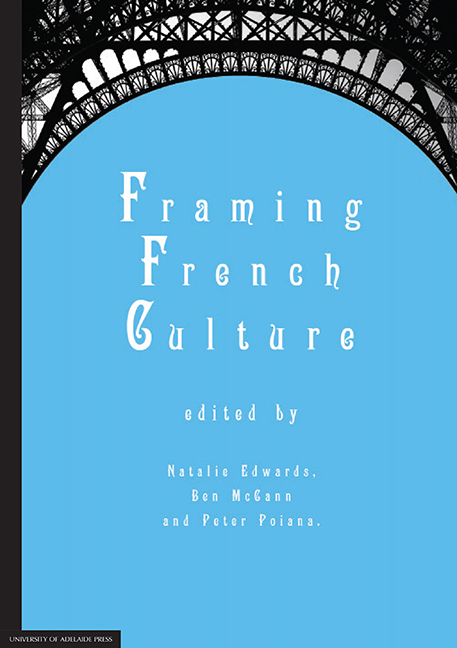Book contents
- Frontmatter
- Contents
- Introduction
- Part 1 Historical framings
- 2 Colonial vision: French voyager-artists, Aboriginal subjects and the British Colony at Port Jackson
- 3 An artist in the making: The early drawings of Charles-Alexandre Lesueur during the Baudin expedition to Australia
- 4 Framing New Holland or framing a narrative? A representation of Sydney according to Charles-Alexandre Lesueur
- 5 The Artwork of the Baudin expedition to Australia (1800-1804): Nicolas-Martin Petit's 1802 portrait of an Aboriginal woman and child from Van Diemen's Land
- Part 2 Cultural icons and cinematic framings
- Part 3 Photographic framings
- Part 4 Artistic framings
3 - An artist in the making: The early drawings of Charles-Alexandre Lesueur during the Baudin expedition to Australia
from Part 1 - Historical framings
Published online by Cambridge University Press: 05 February 2016
- Frontmatter
- Contents
- Introduction
- Part 1 Historical framings
- 2 Colonial vision: French voyager-artists, Aboriginal subjects and the British Colony at Port Jackson
- 3 An artist in the making: The early drawings of Charles-Alexandre Lesueur during the Baudin expedition to Australia
- 4 Framing New Holland or framing a narrative? A representation of Sydney according to Charles-Alexandre Lesueur
- 5 The Artwork of the Baudin expedition to Australia (1800-1804): Nicolas-Martin Petit's 1802 portrait of an Aboriginal woman and child from Van Diemen's Land
- Part 2 Cultural icons and cinematic framings
- Part 3 Photographic framings
- Part 4 Artistic framings
Summary
The link between scientific discovery and empire building was never more evident than in the latter decades of the eighteenth century. During that time, as Mary Louise Pratt has noted, the ‘international scientific expedition’ became ‘one of Europe's proudest and most conspicuous instruments of expansion’. For Pratt, this period coincided with the emergence of a new version of Europe's ‘planetary consciousness’ — one which was characterised by ‘the construction of global-scale meaning through the descriptive apparatuses of natural history’.
Empirical observations of the natural world were indeed indispensable to the European Enlightenment ambition of obtaining a complete and taxonomic knowledge of the globe — and thereby gaining mastery over it. At this time, too, there was a growing realisation that the visual could play just as valuable a part in that process as the verbal. Accordingly, by the end of the eighteenth century, it had become common practice for professional artists to be included on scientific expeditions. Their role was to keep a pictorial record of the places visited, the peoples encountered and the specimens of flora and fauna that were collected or otherwise examined. The natural history drawings, ethnographic portraits, coastal profiles and landscapes that they produced, together with the various maps and hydrographic charts that the officers and geographers compiled, formed a rich store of iconographic material that became just as important to the imperial project as the discursive observations to be found in the logbooks and journals that their fellow travellers kept.
This development had profound implications, for both the sciences and the arts. As Bernard Smith has argued, progress in the arts not only paralleled scientific progress but also assisted it by providing scientists with ever more accurate and reliable visual material for analysis. Conversely, the increase in scientific knowledge of the world constituted an ‘enduring challenge to the supremacy of neo-classical values in art and thought’. The artist was henceforth required to depict nature accurately, not enhance or idealise it as the Renaissance had programmatically set out to do. The visual imagery that scientific travellers compiled had to conform to a new ideal of objectivity, as illusory as we now understand that ambition to have been. The pursuit of scientific knowledge thus influenced the development of artistic practices as much as art served and impacted upon science.
- Type
- Chapter
- Information
- Framing French Culture , pp. 53 - 80Publisher: The University of Adelaide PressPrint publication year: 2015



